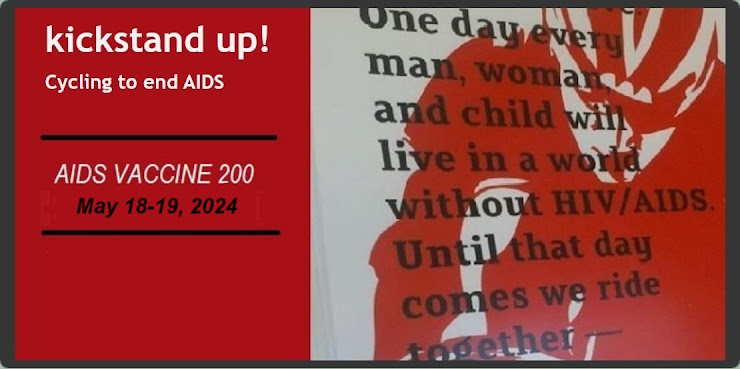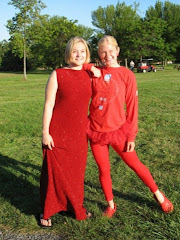2 passes down, 1 to go.
Wait a minute, what’s that extra little pass thrown into the morning?! Beaver Pass - a little 2250’ bump in the road before the “real” climb over Steven's Pass. That’s precisely why this ride day is dedicated to the determination of those who pushed past every obstacle and setback through the 3rd decade in AIDS history.
Whether fighting for policy change or funding, widespread access to the latest treatments and prevention methods or trying something new when the latest idea failed to yield adequate results, it took determination to slow the number of new HIV infections and AIDS deaths in many countries. It will take an equal share of resolve to maintain and advance that trend beyond the obstacles of this decade to the next level of making AIDS history.
Here’s to all those determined to end AIDS, those who depend on them and those who cheer them on.
Donate today to make AIDS history
Tuesday, September 11, 2012
Monday, September 10, 2012
Red Badge of Courage
The summer of 2001 I was still a novice cyclist, preparing for my longest ride to date. Since we would cross the Continental Divide on Day 2 of the 7 day ride across Montana for HIV/AIDS vaccine research, a friend and volunteer coach (who more than earned the moniker “The General”) insisted we train by riding over Blewett Pass. It took a lot of red vines to coax me over that mountain pass under the hot, hot sun so you can bet they’ll be in my jersey pocket tomorrow whether it’s 90 degrees or a traditional Day 2 kinda day.
Tomorrow's Day 2 ride is dedicated to the acts of courage pervasive in the second decade of AIDS in the world. Ryan White, the young hemophiliac banned from public school when diagnosed, lost his fight with AIDS in 1990. The young man had put such a human face on AIDS stigma in a time when services were so desperately needed that Congress soon after passed the Ryan White Care Act. Although it has struggled to survive numerous budget cuts, the Ryan White Care Act continues to this day to make help available to persons affected by HIV.
Princess Diana held an AIDS baby and the world watched. Then she dedicated her very public life to AIDS advocacy.
At the 1992 Republican National Convention, Mary Fisher, an HIV-positive woman, admonished her party for their negligence in the face of the growing HIV and AIDS epidemic:
With gratitude to the Avert AIDS Timeline for reminding us of the many heroes fighting through the peaks and valleys to make AIDS history.
Tomorrow's Day 2 ride is dedicated to the acts of courage pervasive in the second decade of AIDS in the world. Ryan White, the young hemophiliac banned from public school when diagnosed, lost his fight with AIDS in 1990. The young man had put such a human face on AIDS stigma in a time when services were so desperately needed that Congress soon after passed the Ryan White Care Act. Although it has struggled to survive numerous budget cuts, the Ryan White Care Act continues to this day to make help available to persons affected by HIV.
Princess Diana held an AIDS baby and the world watched. Then she dedicated her very public life to AIDS advocacy.
At the 1992 Republican National Convention, Mary Fisher, an HIV-positive woman, admonished her party for their negligence in the face of the growing HIV and AIDS epidemic:
“We have killed each other with our ignorance, our prejudice, and our silence. We may take refuge in our stereotypes, but we cannot hide there long, because HIV asks only one thing of those it attacks. Are you human? ” -Mary FisherThe FDA approved several new drugs found to be helpful when combined into individually customized “drug cocktails” for those with AIDS but they offered little help to those infected with HIV but not yet showing symptoms of AIDS. I have personal experience with the heroes of this scenario. Most had cheated death once upon receiving their AIDS diagnosis so were grateful for the extra months – maybe a few years – and the quality of life improvement offered by combination drug therapy but they knew a cure was out of their reach. They offered their bodies for every possible human trial, carried pamphlets to friends and public places to advocate for safe sex and HIV testing, told their story and fought to their dying day that others could avoid their fate. My brother, Bret, was one of these heroes, as were several others whose example we seek to carry on – Peter Harding, Donald David Fehrenbach, Phil Zwickler – but theirs are only a few of the very many acts of courage in this period of AIDS history.
With gratitude to the Avert AIDS Timeline for reminding us of the many heroes fighting through the peaks and valleys to make AIDS history.
Sunday, September 9, 2012
In Search of the Summit
3,022 feet to the summit, over 38 miles of climbing. Construction on the downhill means the reward will be briefly enjoyed, but that’s not unlike the first decade of AIDS in the world.
Tomorrow’s ride over Snoqualmie Pass is dedicated to the pioneers of that first decade. Doctors, nurses, druggist and scientists who keenly observed, reported and tracked mysterious trends. The fatally ill who faced no hope and a sure, lingering death. Loved ones who became unlikely activists, quickly organized to disseminate any and all new information in a valiant attempt to save others; AIDS charities and service organizations formed. Even as the death toll rose to staggering levels, they were not deterred; their loved ones would not die in vain.
The unknown bred fear. Fear breeds prejudice and AIDS would carry its stigma from homosexuals to drug addicts to foreigners to a 13 year old hemophiliac, banned from his public classroom for fear his AIDS would spread to his classmates.
It was also a time too easy to be in denial that one’s life could be impacted by AIDS... "Let’s see, never shared needles, not a homosexual or had a blood transfusion and since I never plan to do these things, I’m safe."
The WHO reported in their 1987 Weekly epidemiological record ‘'Global Statistics” that 150,000 cases of AIDS were expected to develop in the following 12 months and up to 3 million within the next 5 years from the estimated 5-10 million people infected with HIV worldwide.
On December 1, 1988, the first World AIDS Day ushered in a turning point. Thousands of demonstrators had shut down FDA headquarters earlier that year in a successful effort to convince the FDA to fast track the approval of several promising drugs and soon a human trial of the drug AZT would offer the hope needed to fight another day.
The Avert AIDS Timeline offers many insights into the pioneers and the mountains they tackled in this early period in AIDS history. Many of them never made it to the top, let alone enjoyed that downhill reward. In light of their tenacity in the face of unbelievable odds, I can manage a 40 miles climb.
Tomorrow’s ride over Snoqualmie Pass is dedicated to the pioneers of that first decade. Doctors, nurses, druggist and scientists who keenly observed, reported and tracked mysterious trends. The fatally ill who faced no hope and a sure, lingering death. Loved ones who became unlikely activists, quickly organized to disseminate any and all new information in a valiant attempt to save others; AIDS charities and service organizations formed. Even as the death toll rose to staggering levels, they were not deterred; their loved ones would not die in vain.
"In many parts of the world there is anxiety, bafflement, a sense that something has to be done - although no one knows what." -The New York Times
The unknown bred fear. Fear breeds prejudice and AIDS would carry its stigma from homosexuals to drug addicts to foreigners to a 13 year old hemophiliac, banned from his public classroom for fear his AIDS would spread to his classmates.
It was also a time too easy to be in denial that one’s life could be impacted by AIDS... "Let’s see, never shared needles, not a homosexual or had a blood transfusion and since I never plan to do these things, I’m safe."
The WHO reported in their 1987 Weekly epidemiological record ‘'Global Statistics” that 150,000 cases of AIDS were expected to develop in the following 12 months and up to 3 million within the next 5 years from the estimated 5-10 million people infected with HIV worldwide.
On December 1, 1988, the first World AIDS Day ushered in a turning point. Thousands of demonstrators had shut down FDA headquarters earlier that year in a successful effort to convince the FDA to fast track the approval of several promising drugs and soon a human trial of the drug AZT would offer the hope needed to fight another day.
The Avert AIDS Timeline offers many insights into the pioneers and the mountains they tackled in this early period in AIDS history. Many of them never made it to the top, let alone enjoyed that downhill reward. In light of their tenacity in the face of unbelievable odds, I can manage a 40 miles climb.
Friday, September 7, 2012
The Only Way Down is Up
No hills. Only mountains.
 Must have felt that way 30 years ago as doctors, nurses and the CDC faced a mysterious wasting disease viciously attacking young people that only seemed to grow worse as it became better known as AIDS.
Must have felt that way 30 years ago as doctors, nurses and the CDC faced a mysterious wasting disease viciously attacking young people that only seemed to grow worse as it became better known as AIDS.
Mountains can consume a landscape but are not insurmountable and the best part about rolling down the other side is the momentum used to make the next one seem less ominous.
Over 3 days next week, I’ll pedal my bike over 3 mountain passes – one for each decade of AIDS in the world – recall the struggles and triumphs of the past and visualize the hope we bring to the future.
 Must have felt that way 30 years ago as doctors, nurses and the CDC faced a mysterious wasting disease viciously attacking young people that only seemed to grow worse as it became better known as AIDS.
Must have felt that way 30 years ago as doctors, nurses and the CDC faced a mysterious wasting disease viciously attacking young people that only seemed to grow worse as it became better known as AIDS. Mountains can consume a landscape but are not insurmountable and the best part about rolling down the other side is the momentum used to make the next one seem less ominous.
Over 3 days next week, I’ll pedal my bike over 3 mountain passes – one for each decade of AIDS in the world – recall the struggles and triumphs of the past and visualize the hope we bring to the future.
Subscribe to:
Comments (Atom)









